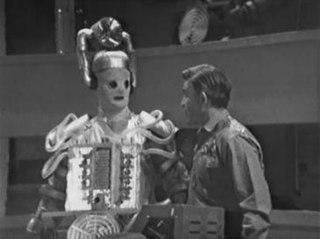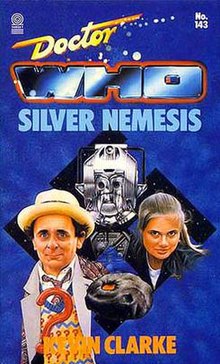Remembrance of the Daleks is the first serial of the 25th season of the British science fiction television series Doctor Who. The serial was first broadcast in four weekly episodes from 5 to 26 October 1988. It was written by Ben Aaronovitch and directed by Andrew Morgan.
Terror of the Autons is the first serial of the eighth season of the British science fiction television series Doctor Who. It was broadcast in four weekly parts on BBC1 from 2 to 23 January 1971.
Day of the Daleks is the first serial of the ninth season of the British science fiction television series Doctor Who, which was first broadcast in four weekly parts from 1 to 22 January 1972. It was the first of four Third Doctor serials to feature the Daleks, which returned to the series for the first time since The Evil of the Daleks (1967).
The Five Doctors is a special feature-length episode of the British science fiction television series Doctor Who, produced in celebration of the programme's 20th anniversary. It had its world premiere in the United States, on the Chicago PBS station WTTW and various other PBS member stations on 23 November 1983, the anniversary date. It was transmitted on BBC1 in the United Kingdom two days later.

The Tenth Planet is the partly missing second serial of the fourth season in the British science fiction television series Doctor Who, which was first broadcast in four weekly parts from 8 to 29 October 1966. It was William Hartnell's last regular appearance as the First Doctor, and the first story to feature the process later termed regeneration, whereby the lead character, The Doctor, undergoes a transformation into a new physical form. Patrick Troughton makes his first, uncredited appearance as the Second Doctor.
Planet of the Spiders is the fifth and final serial of the 11th season of the British science fiction television series Doctor Who, which was first broadcast in six weekly parts on BBC1 from 4 May to 8 June 1974. It was Jon Pertwee's final regular appearance as the Third Doctor, the last regular appearance of Mike Yates, and marks the first, uncredited appearance of Tom Baker as the Fourth Doctor. This serial introduces the term "regenerate" to explain the Doctor's transformation into another appearance.
The Dominators is the first serial of the sixth season of the British science fiction television series Doctor Who, which originally aired in five weekly parts from 10 August to 7 September 1968. The Second Doctor and his travelling companions Jamie McCrimmon and Zoe Heriot work with the Dulcians of the planet Dulkis to prevent the alien Dominators from blowing up Dulkis and using its irradiated remains as spaceship fuel.
Battlefield is the first serial of the 26th season of the British science fiction television series Doctor Who, which was first broadcast in four weekly parts on BBC1 from 6 to 27 September 1989. It was the last to feature Nicholas Courtney as Brigadier Lethbridge-Stewart in Doctor Who.
Earthshock is the sixth serial of the 19th season of the British science fiction television series Doctor Who, which was first broadcast in four twice-weekly parts on BBC1 from 8 to 16 March 1982. This serial marks the final regular appearance of Matthew Waterhouse as Adric and his climactic death, with the final episode featuring unique silent credits in memory of the character. It is also the first to feature the Cybermen since Revenge of the Cybermen in 1975.
The Android Invasion is the fourth serial of the thirteenth season of the British science fiction television series Doctor Who, which was first broadcast in four weekly parts on BBC1 from 22 November to 13 December 1975.
Revenge of the Cybermen is the fifth and final serial of the 12th season of the British science fiction television series Doctor Who, which was first broadcast in four weekly parts on BBC1 from 19 April to 10 May 1975. It was the first to feature the Cybermen since The Invasion (1968) and the last until Earthshock (1982).
Eric Saward is a British radio scriptwriter who worked for the BBC as a television script editor and screenwriter on the science fiction series Doctor Who from 1982 until 1986. He wrote the stories The Visitation (1982), Earthshock (1982), Resurrection of the Daleks (1984) and Revelation of the Daleks (1985).

The Ark is the sixth serial of the third season of the British science fiction television series Doctor Who, which was first broadcast in four weekly parts from 5 to 26 March 1966.
Destiny of the Daleks is the first serial of the 17th season of the British science fiction television series Doctor Who, which was first broadcast in four weekly parts on BBC1 from 1 September to 22 September 1979. The story introduces Lalla Ward as the newly regenerated Romana.
Death to the Daleks is the third serial of the 11th season of the British science fiction television series Doctor Who, which was first broadcast in four weekly parts on BBC1 from 23 February to 16 March 1974.
Kinda is the third serial of the 19th season of the British science fiction television series Doctor Who, which was first broadcast in four twice-weekly parts on BBC1 from 1 to 9 February 1982.
The Invasion is the partly missing third serial of the sixth season of the British science fiction television series Doctor Who, which was first broadcast in eight weekly parts from 2 November to 21 December 1968.

The twenty-fifth season of British science fiction television series Doctor Who began on 5 October 1988. It comprised four separate serials, beginning with Remembrance of the Daleks and ending with The Greatest Show in the Galaxy. To mark the 25th anniversary season, producer John Nathan-Turner brought back the Daleks and the Cybermen. The American New Jersey Network also made a special behind-the-scenes documentary called The Making of Doctor Who, which followed the production of the 25th anniversary story Silver Nemesis. Andrew Cartmel script edited the series.

The twelfth season of British science fiction television series Doctor Who began on 28 December 1974 with Tom Baker's first serial Robot, and ended with Revenge of the Cybermen on 10 May 1975.




